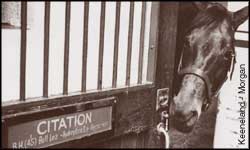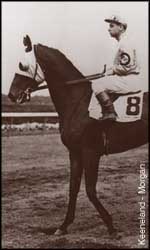| |
Triple Crowns past, present and future
By Dave Johnson
Special to ESPN.com
In the spring of 1948, Calumet Farm's Citation won thoroughbred racing's greatest prize: the Triple Crown. But to realize how tough a campaigner he was and how different the racing game is today, just check Citation's past performance line between the Preakness and the Belmont. Yes, I said between.
|  | | 1948 Triple Crown winner Citation won the Jersey Stakes between victories in the Preakness and Belmont. |
First of all, Citation caught a sloppy track in the Kentucky Derby and then had to chase his swift stablemate Coaltown, who set a rapid pace, going three-quarters of a mile in 1:11 2/5. That's two-fifths of a second faster than sprinter Shecky Greene's time to that mark in Secretariat's Derby, and that was on a fast track!
An off track also awaited Citation at the Preakness, only this time instead of being rated "sloppy", the Pimlico strip was called "heavy" (When was the last time you saw a track labeled "heavy?" For me, it was when I was calling races back at Fairmount Park in Collinsville, Ill.). But nevertheless, Citation was sent off at ten cents on the dollar and despite the muck, led at every pole. His time was a slow 2:02 2/5, because of the track condition, but this outing was certainly more strenuous than a workout.
Here is where we separate the trainers of today from the greats of yesteryear. Seven days after the Preakness, Jimmy Jones sent the eventual Triple Crown winner to Garden State Park on May 29, 1948 to "sharpen him up" in the Jersey Stakes (which he won by eleven lengths). Can you imagine that happening today? Yes, Woody Stephens did win the Met Mile with Conquistador Cielo on the Monday before he won the Belmont in 1982. But Conquistador Cielo did not run in either the Kentucky Derby or the Preakness.
So two weeks later, Citation and Jones go into the Belmont Stakes, where six other trainers entered horses. They hoped Citation was tired and could be beaten. In truth though, Citation almost beat himself, stumbling badly after starter George Cassidy pressed the button to open the gates and send them on their mile and a half journey. Jockey Eddie Arcaro quickly got Citation back on all fours and was in front by the clubhouse turn. They won by eight.
But, Citation was not the only one to compete in races sandwiched between Triple Crown events. Native Dancer, after suffering his only lifetime loss in the 1953 Kentucky Derby, won the Withers before conquering the Preakness and Belmont.
Between May 1 and June 5, 1943, Count Fleet won the Kentucky Derby, the Preakness, the Withers and the Belmont.
So what does all this mean? It means horses are trained much more conservatively today. Possibly because there is so much more at stake beyond the Triple Crown. Remember the winner of last year's $4 million Breeders' Cup Classic? A 3-year-old named Cat Thief.
Nothing is sacred anymore. Not even the Triple Crown.
|  | | During his successful 1943 Triple Crown campaign, Count Fleet also won the Withers Stakes. |
One way to bolster the Crown a bit and encourage more match-ups in the spring classics is to dramatically increase the purse money of each race. It has to be done in this age when a million-dollar race isn't necessarily that unique. And as far as bonuses go, let's stay away from one as ill-conceived as to reward a horse who manages to survive the Triple Crown. The horse who wins the Triple Crown is the only one who should get a bonus, and it should be a big one!
We have heard so much talk about how and when this year's Triple Crown fell apart. But did it really? Or are we just spoiled? Think for a moment about the incredible odds, that we would have three Belmonts in-a-row with the Triple Crown at stake. Still, there will be many who will call for a change in the dates of the Triple Crown races. Some will say that if we had a month between each event, then horses like Fusaichi Pegasus and Red Bullet would have made all three. Maybe. But I do not think that we should change the tradition and uniqueness of the current schedule. It would dilute the Triple Crown, and dim the accomplishments of the eleven before, who managed this amazing feat.
Even though this is a website devoted primarily to the thoroughbred, it is still worthy to note what happened when the rules were changed in harness racing's best-known race, the Hambletonian. Until the mid-1990's, a Hambletonian winner had to win two heats. Sometimes that meant racing the mile four times in one afternoon. That really was too much.
But now, the field for the big race is determined through eliminations one week prior to what has become the Hambletonian final.
And the biggest reason for this change was television.
No one could set the final heat's post time for T.V. in the "old" system because no one could predict how many heats their would ultimately be! But a price was paid for these changes: a loss of the tradition and unique qualities that made a Hambletonian winner really special. Forget about stamina. Just get those commercials in before the six o'clock news.
Let's just hope that the fathers of our sport keep the Triple Crown the way it is.
Speaking of change: as many of you know, I had the honor of being a part of the ABC Sports team that broadcasted Triple Crown events for 23 years. It was a great ride. But next year, NBC will take over and I know they will do a great job. In July, I hope to write a column or two on my experiences with ABC and the televising of the Triple Crown. From Howard Cosell, Eddie Arcaro and Bill Hartack to Jim McKay, Al Michaels and Charlsie Cantey - It will be fun to reminisce.
In two weeks, this column will share some personal thoughts about the four-day race meeting known as Royal Ascot in London, which takes place June 20 through 23. What is especially noteworthy about Royal Ascot this year is that jockey Jerry Bailey will ride there for the first time. I predict a stunning success for the premier rider of our land on their soil.
Until then, take a deep breath, toast Wayne Lukas on his execution of an accomplished game plan in the Belmont, salute Pat Day for giving Commendable the benefit of his great timing and finesse, and think how much we have to look forward to this summer, when 3-year-olds meet again in races like the Haskell and the Travers. The fun may just be starting.
(In addition to his role with ABC Sports, Dave Johnson has been one of ESPN's premier horse racing analysts since 1985).
|
| |
